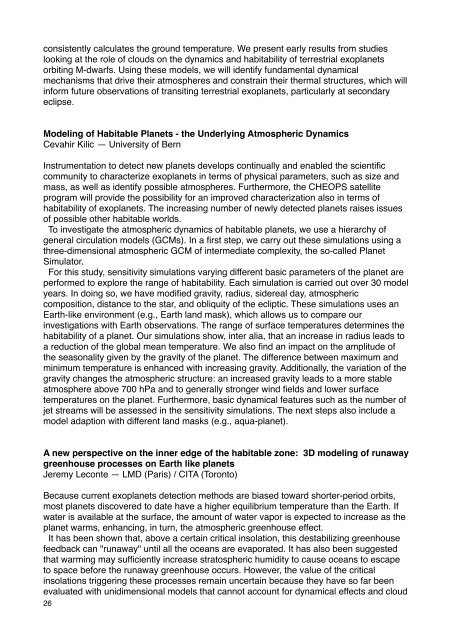Exoclimes_Conference_booklet1
Exoclimes_Conference_booklet1
Exoclimes_Conference_booklet1
You also want an ePaper? Increase the reach of your titles
YUMPU automatically turns print PDFs into web optimized ePapers that Google loves.
consistently calculates the ground temperature. We present early results from studies<br />
looking at the role of clouds on the dynamics and habitability of terrestrial exoplanets<br />
orbiting M-dwarfs. Using these models, we will identify fundamental dynamical<br />
mechanisms that drive their atmospheres and constrain their thermal structures, which will<br />
inform future observations of transiting terrestrial exoplanets, particularly at secondary<br />
eclipse.<br />
Modeling of Habitable Planets - the Underlying Atmospheric Dynamics<br />
Cevahir Kilic! — University of Bern!<br />
Instrumentation to detect new planets develops continually and enabled the scientific<br />
community to characterize exoplanets in terms of physical parameters, such as size and<br />
mass, as well as identify possible atmospheres. Furthermore, the CHEOPS satellite<br />
program will provide the possibility for an improved characterization also in terms of<br />
habitability of exoplanets. The increasing number of newly detected planets raises issues<br />
of possible other habitable worlds.<br />
To investigate the atmospheric dynamics of habitable planets, we use a hierarchy of<br />
general circulation models (GCMs). In a first step, we carry out these simulations using a<br />
three-dimensional atmospheric GCM of intermediate complexity, the so-called Planet<br />
Simulator.<br />
For this study, sensitivity simulations varying different basic parameters of the planet are<br />
performed to explore the range of habitability. Each simulation is carried out over 30 model<br />
years. In doing so, we have modified gravity, radius, sidereal day, atmospheric<br />
composition, distance to the star, and obliquity of the ecliptic. These simulations uses an<br />
Earth-like environment (e.g., Earth land mask), which allows us to compare our<br />
investigations with Earth observations. The range of surface temperatures determines the<br />
habitability of a planet. Our simulations show, inter alia, that an increase in radius leads to<br />
a reduction of the global mean temperature. We also find an impact on the amplitude of<br />
the seasonality given by the gravity of the planet. The difference between maximum and<br />
minimum temperature is enhanced with increasing gravity. Additionally, the variation of the<br />
gravity changes the atmospheric structure: an increased gravity leads to a more stable<br />
atmosphere above 700 hPa and to generally stronger wind fields and lower surface<br />
temperatures on the planet. Furthermore, basic dynamical features such as the number of<br />
jet streams will be assessed in the sensitivity simulations. The next steps also include a<br />
model adaption with different land masks (e.g., aqua-planet).<br />
A new perspective on the inner edge of the habitable zone: 3D modeling of runaway<br />
greenhouse processes on Earth like planets<br />
Jeremy Leconte — LMD (Paris) / CITA (Toronto)<br />
Because current exoplanets detection methods are biased toward shorter-period orbits,<br />
most planets discovered to date have a higher equilibrium temperature than the Earth. If<br />
water is available at the surface, the amount of water vapor is expected to increase as the<br />
planet warms, enhancing, in turn, the atmospheric greenhouse effect.<br />
It has been shown that, above a certain critical insolation, this destabilizing greenhouse<br />
feedback can "runaway" until all the oceans are evaporated. It has also been suggested<br />
that warming may sufficiently increase stratospheric humidity to cause oceans to escape<br />
to space before the runaway greenhouse occurs. However, the value of the critical<br />
insolations triggering these processes remain uncertain because they have so far been<br />
evaluated with unidimensional models that cannot account for dynamical effects and cloud<br />
26


